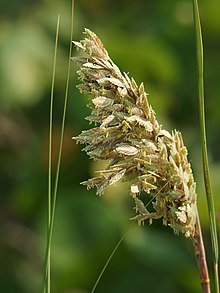Sea oats
| Sea oats | |
|---|---|
 |
|
| Scientific classification | |
| Kingdom: | Plantae |
| (unranked): | Angiosperms |
| (unranked): | Monocots |
| (unranked): | Commelinids |
| Order: | Poales |
| Family: | Poaceae |
| Genus: | Uniola |
| Species: |
U. paniculata L. |
Uniola paniculata or sea oats, also known as seaside oats, araña, and arroz de costa, is a tall subtropical grass that is an important component of coastal sand dune and beach plant communities in the southeastern United States, eastern Mexico and some Caribbean islands. Its large seed heads that turn golden brown in late summer give the plant its common name. Its tall leaves trap wind-blown sand and promote sand dune growth, while its deep roots and extensive rhizomes act to stabilize them, so the plant helps protect beaches and property from damage due to high winds, storm surges and tides. It also provides food and habitat for birds, small animals and insects.
Uniola paniculata is a tall, erect perennial grass that can grow to 1 to 2 m (3.3 to 6.6 ft) in height. Its long, thin leaves reach lengths of 20 to 40 cm (8 to 15.5 in) and are about 0.6 cm (0.24 in) in width, tapering to a pointed apex. The plant produces inflorescences of flat spikelets, each of which contains 10 to 12 wind-pollinated florets. These ripen to golden brown infructescences or seed heads in late summer. The seeds are dispersed by wind and can be carried long distances by storms and ocean currents, but reproduction commonly occurs vegetatively by forming buds around stem bases.
The plant forms dense surface roots and penetrating deep roots that are colonized by beneficial organisms such as micorrhizal fungi. Rhizomes are elongate and produce extensive lateral growth. They root readily when buried in sand.
...
Wikipedia
